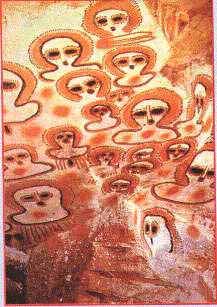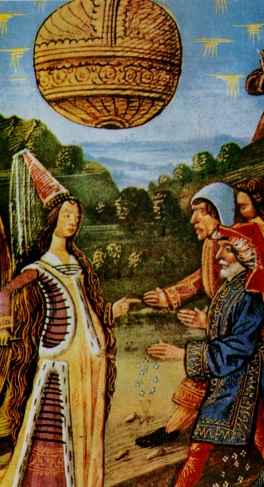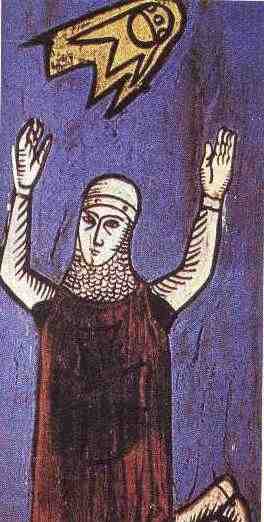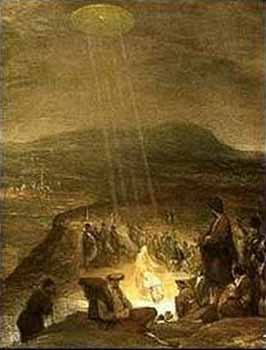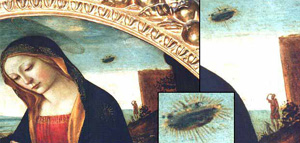This section of our symbols website features images that have been symbolic in the ancient past. Seeing these symbolic images immediately evokes emotions or thoughts in relation to the image.
These symbolic images come to us through paintings, stone carvings, artifacts, etc. Here are some of the most popular symbolic images from ancient history.
|
Wandjina petroglyphs from Kimberley, Australia. |
|
15th Century |
|
Rome |
|
A disk-shaped object is shining light beams down on John the Baptist and Jesus – Fitzwilliam Museum, Cambridge, England – Painted in 1710 by Flemish artist Aert De Gelder. It depicts a classic, hovering, silvery, saucer-shaped UFO shining beams of light down on John the Baptist and Jesus. What could have inspired the artist to combine these two subjects? |
|
This painting is called “The Madonna with Saint Giovannino“. It was painted in the 15th century by Domenico Ghirlandaio (1449-1494) and is part of the Loeser collection in the Palazzo Vecchio. Above Mary’s right shoulder is a disk-shaped object. Below is a blow-up of this section, and a man and his dog can clearly be seen looking up at the object. |
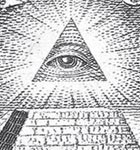 The All-Seeing Eye – The Eye of Providence (or the all-seeing eye of God) is a symbol showing an eye often surrounded by rays of light or glory and usually enclosed by a triangle. It is sometimes interpreted as representing the eye of God watching over humankind (or divine providence).In the modern era, the most notable depiction of the eye is the reverse of the Great Seal of the United States, which appears on the United States one-dollar bill. The All-Seeing Eye – The Eye of Providence (or the all-seeing eye of God) is a symbol showing an eye often surrounded by rays of light or glory and usually enclosed by a triangle. It is sometimes interpreted as representing the eye of God watching over humankind (or divine providence).In the modern era, the most notable depiction of the eye is the reverse of the Great Seal of the United States, which appears on the United States one-dollar bill. |
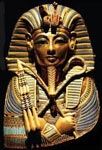 Tutankhamun – is a symbolic image of Egypt, it is well known throughout the entire world, and it symbolized Egypt and it`s majestic and royal allure. Tutankhamun – is a symbolic image of Egypt, it is well known throughout the entire world, and it symbolized Egypt and it`s majestic and royal allure. |
 The Mona Lisa – The Mona Lisa is a 16th-century portrait painted in oil on a poplar panel by Leonardo di ser Piero da Vinci during the Renaissance in Florence, Italy. It is symbolic of beautiful artwork, and it is known worldwide. The Mona Lisa – The Mona Lisa is a 16th-century portrait painted in oil on a poplar panel by Leonardo di ser Piero da Vinci during the Renaissance in Florence, Italy. It is symbolic of beautiful artwork, and it is known worldwide. |
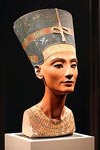 Nefertiti – is well known throughout the world, as being a great queen, she is symbolic of Egyptian Royalty. Nefertiti (ca. 1370 BC – ca. 1330 BC) was the Great Royal Wife of the Egyptian Pharaoh Akhenaten. Nefertiti and her husband were known for a religious revolution in which they started to worship one god only. This was Aten or the sun disc. Nefertiti – is well known throughout the world, as being a great queen, she is symbolic of Egyptian Royalty. Nefertiti (ca. 1370 BC – ca. 1330 BC) was the Great Royal Wife of the Egyptian Pharaoh Akhenaten. Nefertiti and her husband were known for a religious revolution in which they started to worship one god only. This was Aten or the sun disc. |
 IHS symbol – The IHS is a monogram of the name of Jesus Christ. From the third century, the names of our Saviour have sometimes been shortened, particularly in Christian inscriptions (IH and XP, for Jesus and Christus). In the next century, the “sigla” (chi-rho) occurs not only as an abbreviation but also as a symbol. From the beginning, however, in Christian inscriptions, the Nomina Sacra, or names of Jesus Christ, were shortened by contraction; thus, IC and XC or IHS and XPS for Iesous Christos. IHS symbol – The IHS is a monogram of the name of Jesus Christ. From the third century, the names of our Saviour have sometimes been shortened, particularly in Christian inscriptions (IH and XP, for Jesus and Christus). In the next century, the “sigla” (chi-rho) occurs not only as an abbreviation but also as a symbol. From the beginning, however, in Christian inscriptions, the Nomina Sacra, or names of Jesus Christ, were shortened by contraction; thus, IC and XC or IHS and XPS for Iesous Christos. |
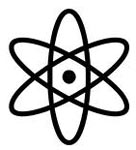 Atom Symbol – The international symbol for the atom, depicting three well-defined electron orbits around a nucleus. This symbolic image is known throughout the world. Atom Symbol – The international symbol for the atom, depicting three well-defined electron orbits around a nucleus. This symbolic image is known throughout the world. |
 Crucifix – cross with a representation of Jesus’ body hanging from it. The crucifix is one of the ultimate symbolic images that appear in our daily lives. It is primarily used in Catholic, Anglican, Lutheran, and Eastern Orthodox churches (where the figure is painted), and it emphasizes Christ’s sacrifice – his death by crucifixion. Crucifix – cross with a representation of Jesus’ body hanging from it. The crucifix is one of the ultimate symbolic images that appear in our daily lives. It is primarily used in Catholic, Anglican, Lutheran, and Eastern Orthodox churches (where the figure is painted), and it emphasizes Christ’s sacrifice – his death by crucifixion. |
 The Trihsula is a trident spear that is the emblem of the god Shiva. The weapon symbolizes empire and the irresistible force of transcendental reality. The Trihsula is a trident spear that is the emblem of the god Shiva. The weapon symbolizes empire and the irresistible force of transcendental reality. |
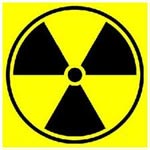 Plutonium – is a transuranic radioactive chemical element with the chemical symbol Pu and atomic number 94. The plutonium symbol is symbolic of radioactivity, and to many, it is a symbol that stands for the destruction of the environment. Plutonium – is a transuranic radioactive chemical element with the chemical symbol Pu and atomic number 94. The plutonium symbol is symbolic of radioactivity, and to many, it is a symbol that stands for the destruction of the environment. |
 Tree of Life – The tree of life is symbolic of Adam and Eve, and also, with the fact that all life on earth is related, has been used in science, religion, philosophy, and mythology. Tree of Life – The tree of life is symbolic of Adam and Eve, and also, with the fact that all life on earth is related, has been used in science, religion, philosophy, and mythology. |
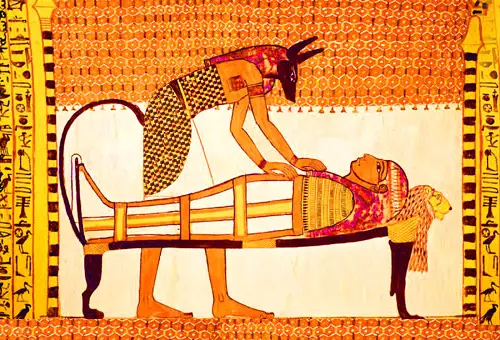 Anubis Mural – The mural was found in the burial chamber of Sennedjem, an eminent artisan who worked on the pharaohs’ tombs. Sennedjem’s tomb was found fully intact in 1886 in the Valley of the Kings. The mural depicts the Egyptian God of the afterlife, Anubis, tending to Sennedjem’s casket. This jackal-headed God was associated with guiding the souls of the dead to the afterlife and also performing judgment on the deeds done by the deceased by weighing the heart against the Ma’at. Anubis Mural – The mural was found in the burial chamber of Sennedjem, an eminent artisan who worked on the pharaohs’ tombs. Sennedjem’s tomb was found fully intact in 1886 in the Valley of the Kings. The mural depicts the Egyptian God of the afterlife, Anubis, tending to Sennedjem’s casket. This jackal-headed God was associated with guiding the souls of the dead to the afterlife and also performing judgment on the deeds done by the deceased by weighing the heart against the Ma’at. |
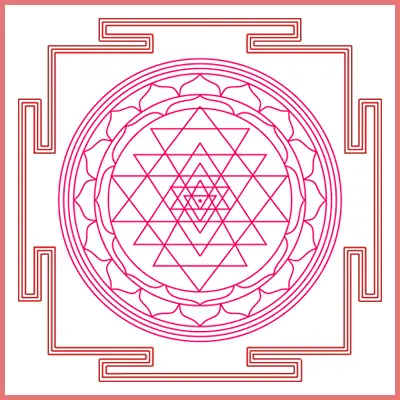 Sri Yantra – Yantra is a mystical geometrical diagram, a visual mantra used in the Hindu tantric traditions. Though Yantra can be a 3-dimensional object, it is often a 2-dimensional diagram with a mantra inscribed on it. Concentrating on the Yantra is believed to yield magical, astrological and spiritual benefits.Sri Yantra is the best-known yantra and symbolizes Tripura Sundari, Goddess of the Shri Vidya school of Hindu tantrism. It comprises a diagram with nine interlocking triangles surrounding and radiating from a central point (Bindu). 5 triangles point downward, representing the female embodiment, Shakti. 4 triangles point upwards, representing Shiva (male). Thus, Sri Yantra symbolizes the union of the Divine masculinity and femininity. Sri Yantra – Yantra is a mystical geometrical diagram, a visual mantra used in the Hindu tantric traditions. Though Yantra can be a 3-dimensional object, it is often a 2-dimensional diagram with a mantra inscribed on it. Concentrating on the Yantra is believed to yield magical, astrological and spiritual benefits.Sri Yantra is the best-known yantra and symbolizes Tripura Sundari, Goddess of the Shri Vidya school of Hindu tantrism. It comprises a diagram with nine interlocking triangles surrounding and radiating from a central point (Bindu). 5 triangles point downward, representing the female embodiment, Shakti. 4 triangles point upwards, representing Shiva (male). Thus, Sri Yantra symbolizes the union of the Divine masculinity and femininity. |

